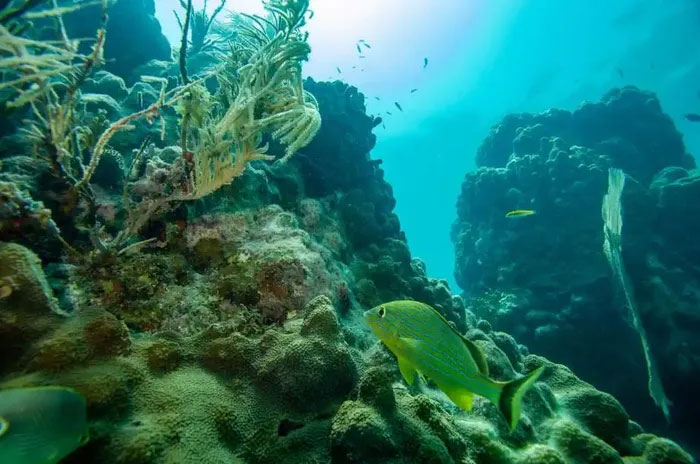Extreme heat is affecting many states in the United States. One phenomenon recorded is that the ocean surface water temperature in and around the Florida Keys, the southernmost island of Florida, increased to abnormal levels this week.
Specifically, at Manatee Bay, an island and administrative area in the Florida Keys island chain, the water surface temperature recorded on the afternoon of July 24 increased to 38.44 degrees Celsius.
Meanwhile, the US National Oceanic and Atmospheric Administration (NOAA) said that normally, at this time, the water surface temperature in these areas is recorded at only about 23 degrees Celsius to 31 degrees Celsius.
Earlier, officials issued warnings about warming sea levels in areas of the southeastern United States, including Florida, as temperatures continue to rise in many parts of the country.
In early July, the World Meteorological Organization (WMO) said that global sea temperatures had hit a monthly record high since May 2023, partly due to the El Nino phenomenon.
Scientists warn that rising sea surface temperatures could threaten marine ecosystems, marine life and affect the livelihoods of fishermen.
Warming oceans are amplifying weather-related disasters, causing deaths and huge economic losses, with estimates of economic losses reaching $1 trillion a year in the coming decades, said marine scientist Deborah Brosnan, founder of environmental risk consultancy Deborah Brosnan & Associates.
Rising ocean temperatures are also accelerating climate change. As water temperatures rise, the oceans lose their ability to perform a vital function of absorbing the world's excess heat.
“Rising ocean temperatures are having and will have huge impacts on land. Strange and dangerous weather patterns will become the norm in places where they have never happened before, and with greater frequency,” said Brosnan.
In recent decades, the world’s oceans have absorbed 90 percent of the warming caused by greenhouse gases. Warming oceans trigger a vicious cycle of higher land temperatures, which in turn contributes to warmer seas. This has a host of climate impacts, including stronger storms, rising sea levels, and the loss of coral reefs and other marine life.
Rising water temperatures are having long-lasting impacts on the most remote places on Earth, with sea ice in Antarctica hitting an all-time low in June 2023, even though it was winter, according to the US National Centers for Environmental Information.
Rising ocean temperatures are affecting millions of people around the world, often with catastrophic results, Bloomberg reported. Hurricanes with high winds are some of the most prominent examples of extreme weather caused by warmer oceans. Higher water temperatures increase the number of storms by adding moisture to the atmosphere.
Global accumulated cyclone energy was nearly double normal in June. In early 2023, Tropical Storm Freddy set a preliminary record as the longest-lasting tropical cyclone on record.
Warmer ocean waters also increase the amount of rain from daily summer storms. Flooding across the northeastern United States in July killed a woman in New York, closed rail lines and devastated Vermont, causing $5 billion in damage.

Rising sea surface temperatures could threaten marine ecosystems. Photo: AFP.
Warming oceans contribute to extreme weather events like droughts and wildfires. Winds in the upper atmosphere are influenced by the ocean below, and warmer seas can cause winds to bend in extreme ways. This leads to areas of high pressure that hold hot air in place for weeks — a phenomenon known as heat domes.
Meanwhile, in Texas (USA), the intense heat has caused the demand for electricity to increase to a record high. In Arizona, scientists on July 25 recorded that the saguaro cactus - a symbol of the American West - had wilted, lost branches and even collapsed during the unprecedented heat wave in this state.
According to scientist Tania Hernandez at the Desert Botanical Garden in Phoenix, Arizona, the extreme heat of over 43 degrees Celsius lasting 25 days in Phoenix has made it difficult for this tree species known as the "giant" of the desert to survive.
Cacti have long been known as plants that can withstand high temperatures to survive, but sometimes still need water and temperatures to drop at night.
On July 25, according to an assessment by a group of scientists from World Weather Attribution - an organization specializing in assessing the role of climate change in extreme weather patterns around the world, extreme weather patterns on both land and ocean, with increasing scale and intensity, are due to the impact of climate change caused by humans.
Scientists say this type of extreme weather has become a global phenomenon. The team predicts that the current heatwave is likely to continue until the end of August.
Minh Hoa (t/h)
Source






![[Photo] Closing of the 11th Conference of the 13th Central Committee of the Communist Party of Vietnam](https://vstatic.vietnam.vn/vietnam/resource/IMAGE/2025/4/12/114b57fe6e9b4814a5ddfacf6dfe5b7f)



























![[Photo] Overcoming all difficulties, speeding up construction progress of Hoa Binh Hydropower Plant Expansion Project](https://vstatic.vietnam.vn/vietnam/resource/IMAGE/2025/4/12/bff04b551e98484c84d74c8faa3526e0)






























































Comment (0)